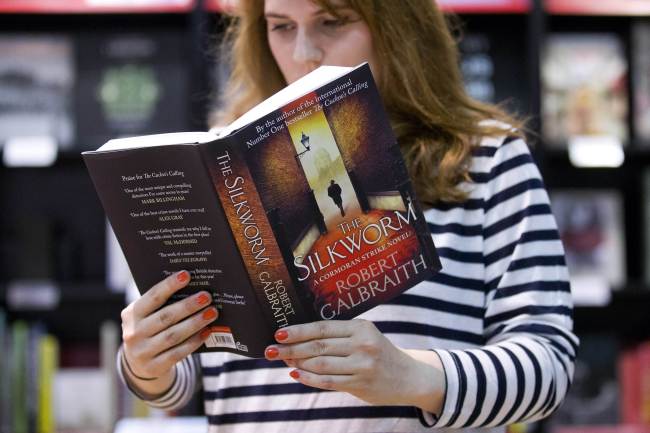 |
| J.K. Rowling. (J.K. Rowling Official Site) |
If J.K. Rowling had as much fun writing “The Silkworm” as I did reading it, she had a blast.
As the woman who created Harry Potter, Rowling became one of the most famous authors on the planet. But she was known as a writer for kids. Her first book for adults, 2012’s “The Casual Vacancy,” made headlines and was a bestseller, but critics were not impressed.
For her next venture, Rowling decided to write in secret. She invented a pseudonym, Robert Galbraith, and created a mystery under that alias.
The manuscript featured Cormoran Strike, a disabled veteran turned private detective; it was submitted to publishers without revealing the author’s true identity. Called “The Cuckoo’s Calling,” it appeared in 2013 with no special fanfare, getting scant, if positive, attention.
 |
| An employee of Waterstones poses with a copy of “The Silkworm” by author Robert Galbraith, aka Harry Potter author J.K. Rowling, as it goes on sale for the first time at a bookshop in London on June 19. J.K. Rowling published her second crime novel on June 19 under the pen name of Robert Galbraith. (AFP-Yonhap) |
That all changed last July when Rowling was unmasked as Galbraith: People suddenly wanted to read the mystery. The months-old book shot up bestseller lists. Rowling admitted that she would have preferred her identity remain secret; some of her oldest friends hadn’t known about her alter ego, and she was “very angry” to learn it had been leaked.
With “The Silkworm,” Rowling returns to Galbraith, framing a novel about a leaked manuscript, the turmoil it creates and its author’s grisly murder.
If this sounds like some sort of commentary, that’s part of the point, I suppose; “In Strike’s opinion,” Galbraith/Rowling writes, “the safest way of ensuring that secret information did not leak was not to tell anybody about it.”
At the same time, the strength of the novel is that this never gets in the way.
As the book begins, Strike is in demand after his last case but struggling a bit financially; he’s a big guy who lost the lower half of one leg in Afghanistan and the barely acknowledged illegitimate son of a recognizable rock star. He has an attractive assistant, Robin, and while she’s engaged and he has sworn off romance, there is a hum of possibility between them.
Despite his crowded schedule, Strike agrees to help a woman find her husband, an author who disappeared in a huff after his agent told him that his latest book, “Bombyx Mori,” was unpublishable. Rumors are flying about its contents, which supposedly trash everyone who works in publishing. The only known copy is locked up in an editor’s safe.
The missing author, arrogant and bitter, descended into writing lurid works after a promising literary debut. He wears an ostentatious cape and is not well liked. His wife’s chief concern is for their disabled daughter, a childlike adult who lives at home, and how she is affected by his absence.
Then Strike finds his body, gruesomely murdered in a manner that echoes the secret manuscript.
This puts attention on the unpublished book, which is a bloody, sexually explicit tale. It is also, we discover, not so secret: The editor, an absent-minded alcoholic, had shared the safe’s combination with his staff.
Strike ends up with a copy, which he finds nightmarish ― “with the feeling that he was diving again into contaminated water, he re-immersed himself in the grotesque world of ‘Bombyx Mori.’” Yet he sticks with it because its targets are clearly the prime suspects: Some reader appears to have been offended … mortally.
Sorting through the possibilities brings Strike to a powerful publisher, a famous author, a friend who died too young and an anonymous satire that led to a spouse’s suicide.
The plot zings along, Strike marches through a wintry London that makes him increasingly vulnerable with his bad leg. Robin’s talents are essential, but she worries that Strike doesn’t see them, and her personal and professional life seems to be on a crash course.
Rowling is extraordinarily good at filling her mystery with fleshed-out characters. Even simple walk-ons ― a nosy neighbor, Robin’s mom ― have dimension, oddity, nuance.
She occasionally overdoes it on description: “When she expelled smoke from her scarlet mouth she looked truly dragonish, with her shining black eyes,” she writes of the domineering agent. But I’m inclined to chalk this up to enthusiasm: The world is so richly imagined, she’s trying to cram it all in.
At the same time, “The Silkworm” is set in the very real world of British publishing, which makes it tempting to look for corollaries. The famous author with a sour expression and a head too big for his body ― could that be Martin Amis? Who is the hip young publisher who first gets the “Bombyx Mori” manuscript? Then, there is the dead man’s mistress, a self-published author of “bloody awful erotic fantasy novels.” Doesn’t she resemble E.L. James?
This is a fun parlor game that leads into a hall of mirrors. We’re reading a book set in a fictional version of the British publishing industry that’s about a book that mocks this fictional publishing industry. Everyone is trying to guess who is who. Next thing you know someone will publish “Bombyx Mori” for real.
All that makes “The Silkworm” swift and satisfying, especially when read through the lens of secrets and fame and the famous writer behind it all.
In the book’s acknowledgments, Rowling says that writing as Robert Galbraith “has been pure joy.” I hope she continues with the Strike mysteries, under whatever name she likes.
By Carolyn Kellogg
(Los Angeles Times)
(MCT Information Services)

